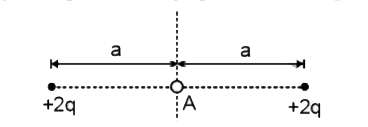A point charge .................
The correct Answer is:1
As sphere is grounded, its net potential must be 0,
Hence KQx+KqR=0
QRx=q
i=dqdt=+QRx2×dxdt
i=QRVx2
Topper's Solved these Questions
- TEST PAPERBOOK - RESONANCECHAPTER - TEST PAPEREXERCISE - CHEMISTRY
37 Videos
- TEST PAPERBOOK - RESONANCECHAPTER - TEST PAPEREXERCISE - CHEMISTRY
37 Videos
- SEQUENCE & SERIES BOOK - RESONANCECHAPTER - SEQUENCE & SERIES EXERCISE - EXERCISE -2 (PART-II : PREVIOUSLY ASKED QUESTION OF RMO)
3 Videos
- TEST PAPERSBOOK - RESONANCECHAPTER - TEST PAPERSEXERCISE - MATHEMATICS
263 Videos
Similar Questions
Knowledge Check
A negative point charge placed at the point A is
 Ain stable equilibrium along x-axisBin unstable equilibrium along y-axisCin stable equilibrium along y-axisDin unstable equilibrium along x-axis
Ain stable equilibrium along x-axisBin unstable equilibrium along y-axisCin stable equilibrium along y-axisDin unstable equilibrium along x-axisPotential at a point 0.1m from an isolated point charge is +100 volt. The nature of the point charge is
ApositiveBNegativeCzeroDeither positive or negativeThe potential at a point 0.1 m from an isolated point charge is + 100 volt. The nature of the point charge is
ApositiveBnegativeCzeroDeither positive or zero
A very small electric dipole with dipole moment p is placed in such in way that it is at a distance r from another point charge +q. The point charge lies on the axis of the dipole . Electric dipole moment is pointing towards the point charge. Determine electric dipole will attract the point charge or repel it ? What will be the magnitude of force between them ?
View SolutionA positive point charge is placed in an external electric field. When we release the point charge in a state of rest then electric force acting on it starts moving it. Will the point charge always follow the electric lines of force?
View SolutionTwo point charges of same magnitude and opposite sign are fixed at point a and B. A third small point charge is to be balanced at point P by the electrostatic force due to these two charges. The point P :

View SolutionGraphically represent the variation of electric potential and electric field due to point charge with respect to the distance from the point charge.
View SolutionTwo point charges of same magnitude and opposite sign are fixed at point a and B. A third small point charge is to be balanced at point P by the electrostatic force due to these two charges. The point P :

View Solution

